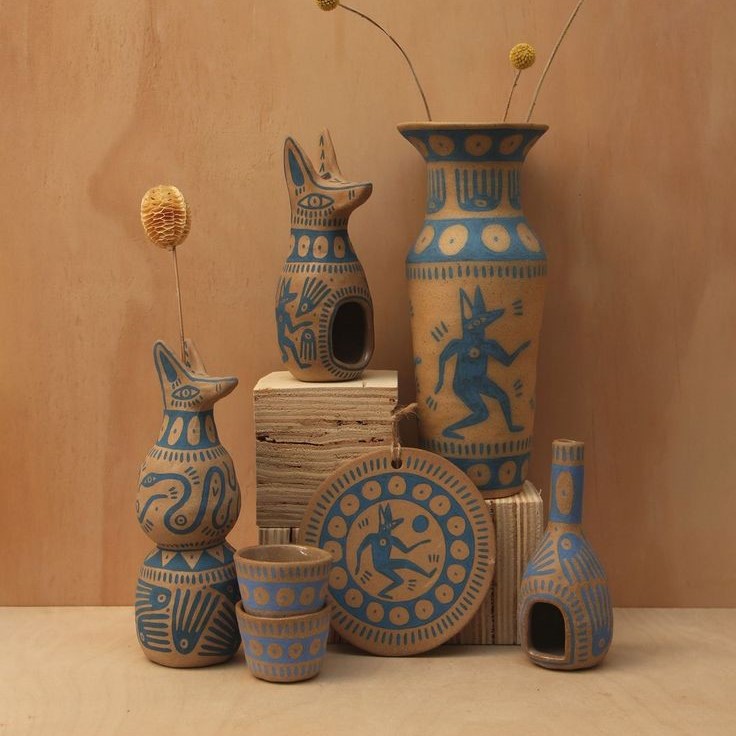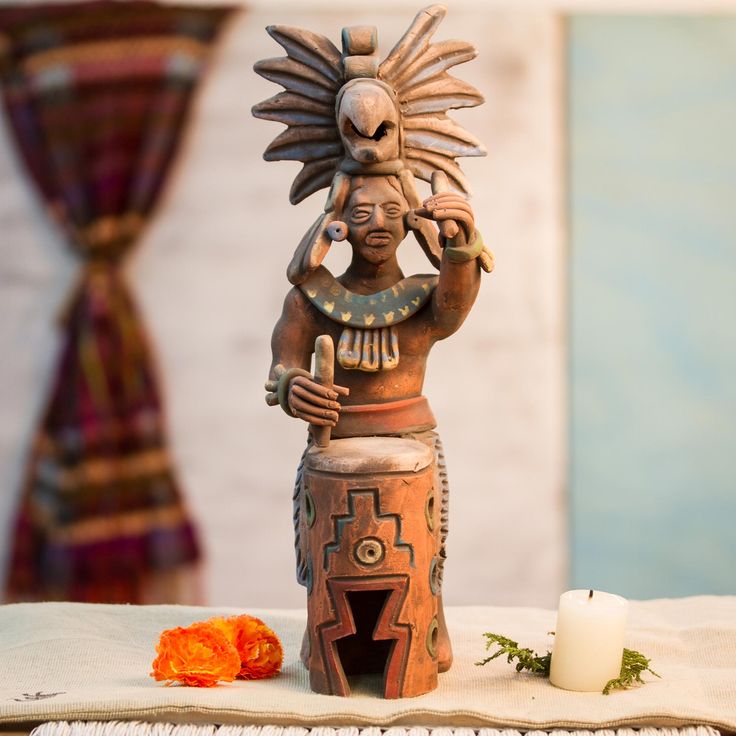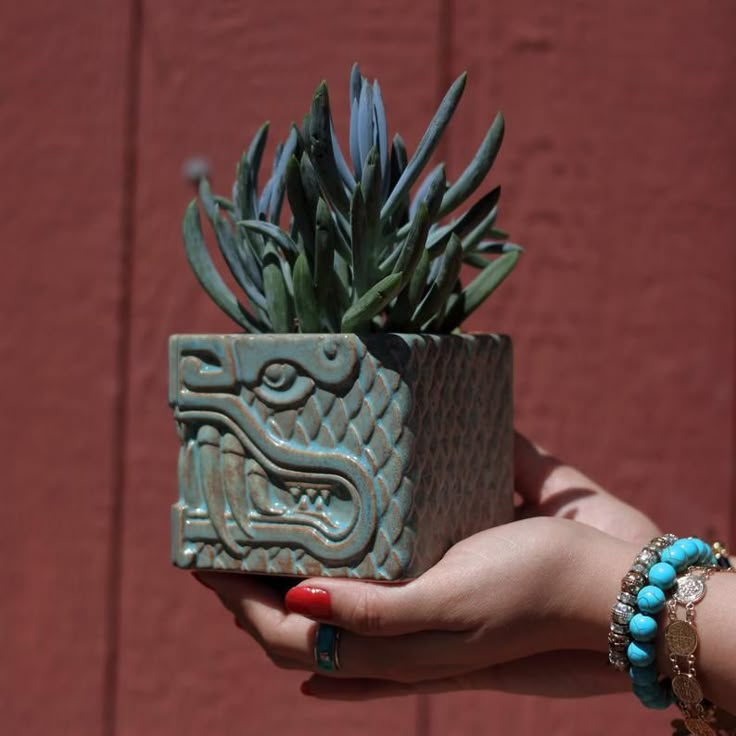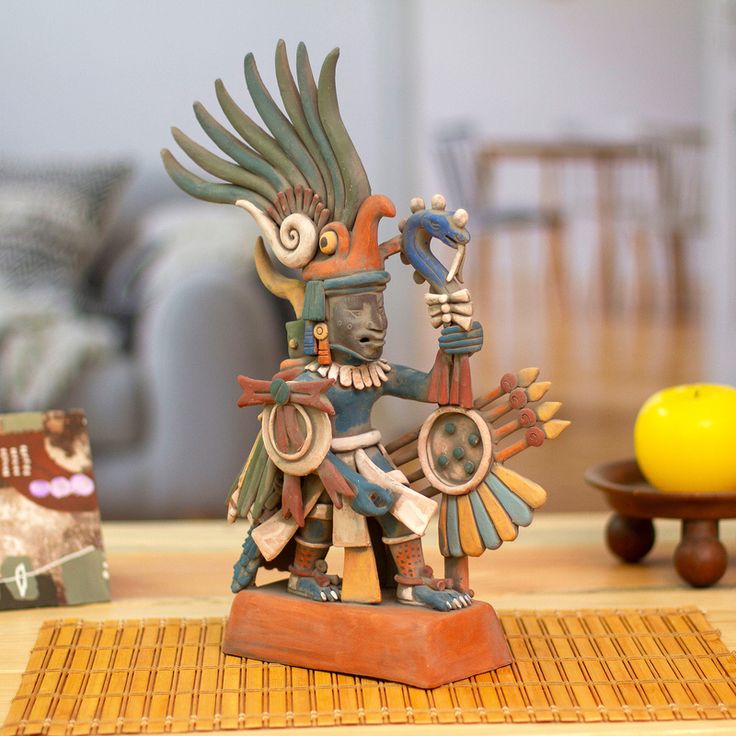The History of Aztec Pottery
Aztec pottery history spans from the 13th to 16th centuries. This period marks the Aztec Empire’s rise and fall. The Aztecs created ceramics with skills passed down through generations. They did not use the potter’s wheel. Instead, they shaped clay by hand or with simple tools. Air-drying and then firing in kilns made their pottery strong. Their ceramics served many roles in daily life. Aztec ceramics carried water, stored grains, and cooked food. Pottery was also vital in religious ceremonies. The Aztecs buried pottery with the dead as offerings to gods.

They sourced clay from the Valley of Mexico’s rich soil. This was central to their craftsmanship. The Aztecs used various natural pigments to decorate their ceramics. These pigments came from nearby resources.
Remarkable is their pottery’s scattering after the Spanish conquest. Despite this, some pieces survived. These surviving pieces help us understand Aztec culture. Museums and archaeologists treasure them today. The study of these ceramics offers a glimpse into the past.
Ceramic styles varied among the Aztecs’ regions. Yet, they all showcased incredible artistry. The Aztec Empire’s influence helped spread ceramic styles far and wide.
In summary, Aztec pottery depicts a storied past full of art, culture, and tradition. It reflects the creativity and resourcefulness of the Aztec people. Their pottery remains a testament to their complex society and technological prowess.
Materials and Techniques in Aztec Ceramic Art
Aztec ceramics were notable not just for their aesthetic appeal, but also for the materials and techniques employed in their creation. Craftsmen selected clays from the Valley of Mexico, benefitting from the region’s diverse geology. Each clay type offered unique properties, suitable for different ceramic products.
Potters fashioned items with their bare hands or used basic shaping tools. They lacked the potter’s wheel, which led to the distinctive Aztec style. Coiling, pinching, and slab-construction were common methods. These allowed for producing a wide range of ceramic forms.
After shaping, artisans dried the ceramics in the open air. Once leather-hard, they would smooth the surfaces with stones and decorate them. Natural pigments provided vibrant colors. These pigments came from earthy minerals and were applied with precision and care.
Finally, they fired the finished pieces in kilns or open fires. Firing temperatures varied. Generally, they were lower than those used today. This process gave the aztec ceramics their lasting durability.

The skill of Aztec potters is evident in the legacy of their work. Despite simple tools and methods, they achieved remarkable results. Their ceramics display a mastery over the materials at their disposal, and continue to impress with their enduring quality.
Types of Aztec Ceramics and Their Uses
Aztec ceramics varied in shape and purpose. They made many types to meet different needs. Everyday items included bowls, jars, and plates. These were for storing, cooking, and eating. Water pots, also called ‘cantaros’, were common. They kept water cool in the hot climate. Grain storage vessels were large and sturdy. They held maize and other staples safe.
Some pottery had special uses. Incense burners, or ‘copaleros’, held burning copal during rituals. Figurines served as religious offerings or toys. Funerary urns held ashes of the deceased. These were often intricately decorated.
Decorative ceramics showed off the Aztecs’ artistry. They made detailed effigy pots, which resembled animals or people. These were not for daily use but for display or religious purposes. There were also ceremonial vessels, distinctively adorned for rituals.
Aztec potters tailored ceramics for distinct functions, reflecting their culture. Each piece tells us about Aztec life and values. From the humble cooking pot to the elaborate ceremonial vessel, all played vital roles in Aztec society.
Symbolism and Iconography in Aztec Pottery
Aztec ceramics were not just functional; they were also rich with symbolism and iconography. From the depictions of gods and goddesses to representations of daily life, each piece held deeper meanings. The images and symbols etched into the aztec ceramics conveyed complex narratives and expressed spiritual beliefs.
Gods and Mythological Beings
The Aztecs honored a multitude of deities, and these gods often appeared in their pottery designs. The ceramics featured detailed representations of deities such as Quetzalcoatl, the feathered serpent, and Tlaloc, the rain god. These icons were deeply revered and held significant religious importance.
Symbols of Power and Warfare
Warfare and power were central to Aztec society, and this was mirrored in their ceramic art. Motifs of eagles and jaguars, symbols of Aztec warriors, were common. Pottery depicting scenes of battle and conquest spoke to the Aztecs’ martial prowess and status.
Agricultural and Natural World Imagery
Agriculture was the backbone of Aztec life, and its imagery was abundant in Aztec ceramics. Fertile earth, maize cobs, and water symbols celebrated the natural world’s bounties. They reflected the Aztecs’ deep respect for and reliance on nature’s cycles.
Geometric and Abstract Patterns
In addition to figurative art, Aztec pottery also included geometric and abstract patterns. These designs often had symbolic meanings, linked to Aztec cosmology and the gods. The use of repetitive patterns also exemplified the Aztecs’ advanced understanding of design principles.
Through every carved line and painted symbol, Aztec ceramics tell a story. They reveal a culture where art interwove with religion, power, and the environment. Understanding this iconography helps us appreciate not just the artistic skill, but the cultural significance of aztec ceramics.
The Role of Ceramics in Aztec Culture and Rituals
Aztec ceramics were more than daily tools. They held deep cultural and ritual significance. In Aztec culture, pottery had a sacred place. For rituals and ceremonies, ceramics were essential. Priests used ceremonial bowls in offerings to the gods. Incense burners filled temples with fragrant smoke. Daily, these rituals reinforced social order and spirituality.
During festivals, inhabitants used special pottery. These items bore symbolic designs. They connected celebrants to deities during these times. Such events enriched communal bonds and reaffirmed beliefs.

In burial practices, pottery played a pivotal role. Aztecs buried the dead with pottery. This act honored the deceased and aided their journey in the afterlife. This custom showed the Aztecs’ belief in life after death.
Feasts and communal meals also used ceramics. Elaborate serving vessels and plates graced tables. These gatherings promoted unity and social cohesion. Feasts highlighted the importance of sharing and generosity.
In all, Aztec ceramics were not mere objects. They helped maintain social structure, religious practices, and the Aztecs’ worldview. Through pottery, we learn about the values that knitted the Aztec society together. Ceramics were integral to their way of life, weaving into the fabric of their existence.
Renowned Aztec Pottery Pieces and Their Significance
Aztec ceramics hold stories of the past. Some pieces stand out for their historical importance. The ‘Aztec Calendar Stone’ is iconic. It’s not just art, it’s a timekeeping system. Displayed in the National Anthropology Museum in Mexico, it draws many visitors.
The ‘Double-Headed Serpent’ is another key piece. It’s an intricate work, showing the skill of Aztec artists. Made from turquoise mosaic, it symbolizes gods and power. It resides in the British Museum, signifying cross-cultural respect.
‘Chacmool’ sculptures are famous as well. These lounging figures were not just decorative. They were religious. Found in temple areas, they held offerings to the gods during ceremonies.
The ‘Xochipilli Statue’ is also significant. This finely carved sculpture represents the god of art, games, beauty, and dance. It reflects the Aztecs’ appreciation for these aspects of life.
These pieces are vital for understanding. They tell about the Aztecs’ beliefs, values, and everyday life. Museums across the world showcase these pieces. People today can marvel at them, just as the Aztecs once did. The legacy of aztec ceramics endures through these renowned artifacts, keeping the history alive for future generations.
Preservation and Study of Aztec Ceramic Artifacts
The preservation and study of Aztec ceramic artifacts are crucial for understanding ancient Mesoamerican cultures. These artifacts, enduring centuries, offer insights into Aztec daily life, religious practices, and artistic achievements. Here’s how Aztec ceramics are preserved and studied today:
Archaeological Excavations
- Uncovering Pottery Pieces: Archaeologists play a crucial role in uncovering pottery pieces during excavation digs. These digs often take place at historical sites where ancient civilizations, like the Aztecs, once thrived. The discovery of ceramics is essential for understanding the material culture of these societies.
- Documentation Process: Each pottery piece found is meticulously documented to ensure accurate historical records. Archaeologists take notes on the location, depth, and context of each find to provide comprehensive details for future analysis. This meticulous documentation is vital for further research and understanding.
- Preservation Practices: After excavation, the preservation of each find is approached with great care. This involves cleaning, stabilizing, and sometimes applying protective coatings to prevent deterioration. Proper preservation techniques are crucial to maintaining the integrity of the artifacts for further study.
Restoration Efforts
- Piecing Together Fragments: Once the pottery pieces are excavated, experts begin the restoration process. They carefully piece together fragments to reconstruct the original form of the ceramics. This meticulous work requires a keen eye and an understanding of the pottery’s original design.
- Restoration to Original State: The goal of restoration is to return the artifacts as close to their original state as possible. This may involve using specially formulated adhesives and techniques that respect the original materials. The expert restorers aim to balance between the integrity of the artifact and its aesthetic presentation.
- Ethical Restoration Practices: Restoration efforts are conducted ethically, with respect for the artifacts’ historical significance. Experts document each step of the restoration process, ensuring transparency and accountability in their work. This documentation helps future researchers understand the changes made during restoration.
Climate-Controlled Storage
- Importance of Controlled Environments: Museums recognize the need for climate-controlled storage solutions to protect ceramics from various damaging factors. Ceramics are sensitive to environmental changes, and fluctuations in temperature or humidity can lead to irreversible damage.
- Protection from External Threats: In climate-controlled settings, ceramics are shielded from harmful effects caused by light exposure, temperature fluctuations, and high humidity. These protections help preserve the colors, textures, and structural integrity of the pottery over time.
- Long-Term Storage Solutions: Museums utilize specialized display cases that not only control climate but also provide a safe viewing environment for the public. Such cases are designed to minimize light exposure and maintain optimal humidity levels, ensuring the ceramics remain in excellent condition.
Advanced Imaging
- Utilizing Non-Invasive Techniques: Advanced imaging technologies, such as 3D scanning, are increasingly used to study ceramics. These non-invasive techniques allow researchers to examine the pottery without making physical contact, thereby preventing any potential damage.
- Revealing Hidden Details: 3D scanning captures intricate details of the ceramics, including textures and markings that may not be visible to the naked eye. This technique illuminates aspects of the pottery that researchers can analyze further without compromising the artifacts themselves.
- Creating Digital Models: The data from advanced imaging can be used to create digital models of the ceramics. These models can be shared with other researchers globally, facilitating collaboration and enabling further study without the need to handle the actual artifacts.
Material Analysis
- Analyzing Clay and Pigments: Material analysis involves scientists studying the clay and pigments used in the pottery. By examining these materials, researchers can glean insights into the resources available to the Aztecs and the techniques they employed in their ceramic production.
- Understanding Manufacturing Techniques: Analyzing materials helps experts understand the manufacturing methods used by the Aztecs. Information such as the clay’s mineral composition and pigment sources reveals not only the artisanship but also the cultural practices surrounding pottery creation.
- Connections to Trade and Economy: Material analysis can provide connections to trade networks. Discovering that certain clays or pigments were not locally sourced suggests trade routes and economic relationships with neighboring cultures, further illuminating the social dynamics of the period.
Collaborative Research
- Interdisciplinary Collaboration: Collaborative research is critical in piecing together the historical and cultural contexts of ceramic artifacts. Scholars from various fields, such as archaeology, anthropology, art history, and chemistry, work together to share their expertise.
- Building Comprehensive Narratives: Through collective efforts, researchers develop a more comprehensive understanding of the artifacts. This interdisciplinary approach allows for a fuller exploration of the cultural significance and historical implications of the ceramics.
- Publishing and Sharing Findings: Collaborative studies often result in publications that share findings with both academic and public audiences. These publications contribute to the broader understanding of Aztec culture and heritage while promoting continued research and interest in ancient civilizations.
Museums play a big role in the study of Aztec ceramics. They exhibit artifacts, sharing with the public. Museums also conduct educational programs. These programs engage people in the history and significance of aztec ceramics.
In academia, scholars publish research papers on their findings. This helps spread knowledge about Aztec pottery. It also aids in cultural preservation. Students and enthusiasts alike can learn from these studies.
The preservation of Aztec ceramics not only honors the past but also guides future generations. This work helps keep the Aztec legacy alive. It allows us to appreciate the creativity and complexity of their ceramic artistry.
Contemporary Influence and Legacy of Aztec Ceramic Techniques
The impact of Aztec ceramic techniques extends far beyond their historical era. Today, these ancient practices continue to influence modern potters and artists globally. Craftsmen admire the Aztecs’ hand-crafted methods, often incorporating them into contemporary works. These techniques provide a tactile connection to the past, reinforcing the value of traditional craftsmanship in the digital age.

Aspects of Aztec ceramics, such as the use of coiling and pinching, remain popular. They are celebrated for their simplicity and for the unique touch they offer. Some modern artists use these methods, seeking authenticity and a handmade aesthetic in their creations. The textures and forms achievable with these techniques are timeless, appealing to those who value artisanal qualities in ceramics.
Furthermore, the Aztec emphasis on symbolism and iconography resonates with contemporary artists. They explore similar themes using their local mythology or creating a personal iconography to tell new stories. This homage to Aztec artistry demonstrates how ancient motifs and narratives can find relevance in modern contexts.
Educational institutions also reflect the reverence for Aztec ceramics. Art history courses examine their cultural significance, while practical art classes teach their techniques. Such educational efforts ensure that the legacy of Aztec ceramics lives on, inspiring a new generation of potters and historians.
In summary, the legacy of aztec ceramics permeates the world of contemporary ceramics. The artistry, techniques, and cultural importance of ancient Aztec pottery continue to be relevant and influential. They bridge the past and the present, showcasing the enduring nature of Aztec craftsmanship.
